|
|
Title | Collection Number And Name | Photo Number |
| 1 |
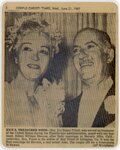 | Ex-U.S. Treasurer weds | P0163 Ivy Baker Priest photograph collection, 1920-1975 | P0163n06_065_0731 |
| 2 |
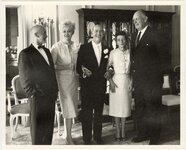 | Ivy Baker Priest and Sidney Smith, second and third from left, on their wedding day | P0163 Ivy Baker Priest photograph collection, 1920-1975 | P0163n06_065_0732 |
| 3 |
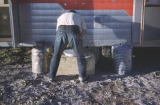 | A large house trailer, seriously damaged traveling the rough road to the C-LDQ, was the solution to the housing problem the second year (1961) of the University of Utah Cooperative Dinosaur Project (UUCDP). (June 1961) | P1048 James H. Madsen Photograph Collection | P1048n010 |
| 4 |
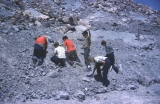 | In the early years, young visitors to the C-LDQ were allowed to dig in the spoil piles next to the excavation. (June 1961) | P1048 James H. Madsen Photograph Collection | P1048n012 |
| 5 |
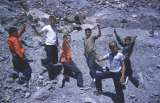 | If the young prospectors were lucky and raised their hands when asked about their success, we would have them "donate" their significant finds to the collection. They were allowed to keep fragments of no scientific value. (June 1961) | P1048 James H. Madsen Photograph Collection | P1048n013 |
| 6 |
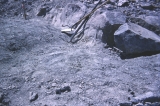 | The fossiliferous unit at the C-LDQ, which consists of poorly stratified to blocky, bentonitic shales, is overlain by a dense, hard, siliceous, freshwater limestone. The surface between the two units shows evidence of channeling as seen here. (June 1961) | P1048 James H. Madsen Photograph Collection | P1048n018 |
| 7 |
 | In numerical order, each fossil is cataloged, measured, identified, and carefully plotted on a base map before it is removed from the Quarry surface. This is just one part of the precise record keeping at the Quarry and compilation of the important data on the thousands of individual fossils exposed and collected there. (July 1961) | P1048 James H. Madsen Photograph Collection | P1048n020 |
| 8 |
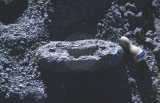 | When a fossil bone is prepared for removal from the Quarry in a plaster jacket, it is first uncovered and left supported on a narrow matrix pedestal. (June 1961) | P1048 James H. Madsen Photograph Collection | P1048n023 |
| 9 |
 | Second, the more fragile and sometimes fractured fossil bones must be enclosed in a burlap and plaster jacket; which like the shell of an egg protects the contents so that each unit can be safely transported to the laboratory for final preparation and study. (June 1961) | P1048 James H. Madsen Photograph Collection | P1048n024 |
| 10 |
 | These paired, pelvic bones of a large Allosaur are called pubes. They are shown here to illustrate the size of the circular opening at the top, which represents the maximum dimension of the oviduct or birth canal. It appears in this case to have been somewhat close to the diameter of a softball in size. (July 1961) | P1048 James H. Madsen Photograph Collection | P1048n025 |
| 11 |
 | This dorsal rib is singularly diagnostic of the presence of the rare theropod, Ceratosaurus in the C-LDQ, however, numerous other bones of this individual were found over the years. | P1048 James H. Madsen Photograph Collection | P1048n026 |
| 12 |
 | This is an exceptional occurrence of fossil bones in the Quarry, an articulated sequence of midcaudal vertebrae of Ceratosaurus. More commonly the fossil bones of a single individual are scattered over an area up to ten meters or more in diameter. | P1048 James H. Madsen Photograph Collection | P1048n027 |
| 13 |
 | This Allosaurus femur, the upper long bone of the hind leg, as found in place at the Quarry, shows displacement at mid-length. Apparently, this was the result of a small, reverse fault having an approximate displacement of about 12 centimeters. The movement occurred long after the enclosing sediments had become lithified, changed to limestone and shale. (July 1961) | P1048 James H. Madsen Photograph Collection | P1048n028 |
| 14 |
 | As an expedient and to minimize the necessary handling and preparation time; each bone, as practical, is wrapped, nested in paper excelsior, and boxed for transportation from the field to the laboratory. More fragile bones, regardless of size, require the conventional plaster and burlap packaging. | P1048 James H. Madsen Photograph Collection | P1048n029 |
| 15 |
 | This is another unusual series of articulated, caudal vertebrae. These bones belong to the uncommon Diplodocid, sauropod dinosaur, Barosaurus; which is represented as a solitary taxon in the C-LDQ. Single taxa are especially important in a mass burial situation like the C-LDQ, because they provide taphonomic data not available from the remains of multiple, but different sized individuals of the same dinosaur. | P1048 James H. Madsen Photograph Collection | P1048n030 |
| 16 |
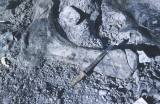 | These are two unrelated bones in place. On the left is an ischium of Barosaurus and on the right an ilium of Allosaurus. (July 1961) | P1048 James H. Madsen Photograph Collection | P1048n033 |
| 17 |
 | Prior to mapping, each bone is carefully identified as to taxa (scientific name) and morphology (elemental name). | P1048 James H. Madsen Photograph Collection | P1048n034 |
| 18 |
 | Most fossil bones are fractured, so must be coated with a preservative, as soon as they are uncovered and allowed to dry, to seal the fossil and fasten the numerous, tiny fragments in place. This step is necessary before the fossils can be safely removed and transported to the laboratory for final preparation and study. | P1048 James H. Madsen Photograph Collection | P1048n035 |